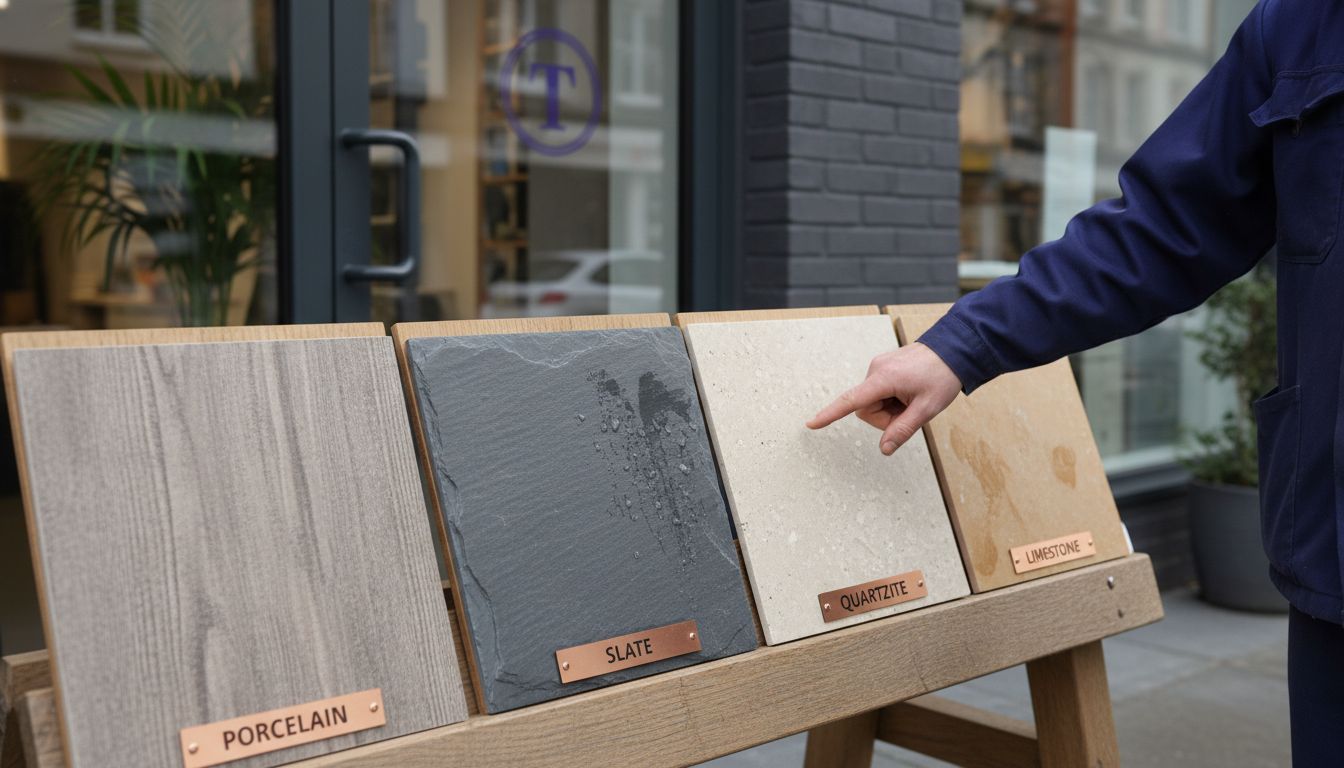
Complete Guide to Outdoor Tiles for UK Projects
Share
Around 70 percent of homeowners believe that any tile can work outside, yet using the wrong type can quickly lead to cracks, stains, or slipping hazards. Choosing outdoor tiles is more than an aesthetic decision, as the right material protects against rain, frost, and heavy foot traffic. Clear information on tile types, benefits, and common myths helps prevent expensive mistakes and ensures your outdoor space stays safe and stylish year-round.
Table of Contents
- Outdoor Tiles Explained: Definition and Myths
- Popular Outdoor Tile Types and Materials
- Benefits of Outdoor Tiles in UK Settings
- Installation, Maintenance, and Lifespan Factors
- Cost Considerations and Comparison With Alternatives
- Common Outdoor Tiling Pitfalls to Avoid
Key Takeaways
| Point | Details |
|---|---|
| Outdoor Tile Selection | Only tiles specifically engineered for outdoor use, like porcelain, should be chosen to avoid issues like cracking and degradation. |
| Material Advantages | Porcelain tiles offer excellent durability and low maintenance, making them ideal for the UK climate. |
| Installation and Maintenance | Proper installation techniques and periodic maintenance are crucial for extending the lifespan of outdoor tiles. |
| Cost Considerations | While porcelain tiles are cost-effective, natural stone options provide unique aesthetics at a higher price point, necessitating careful consideration of long-term value. |
Outdoor Tiles Explained: Definition and Myths
Outdoor tiles are specially engineered ceramic or porcelain surfaces designed to withstand external environments, providing both functional protection and aesthetic enhancement for exterior spaces. According to ceramic industry research, not all tiles are created equal when it comes to outdoor applications, with specific technical properties determining their suitability for external use.
A common misconception is that standard indoor tiles can simply be repurposed outdoors. As research from Atlas Ceramics highlights, only tiles with low porosity and high durability are appropriate for external environments. Inappropriate tile selection can lead to significant problems such as:
- Rapid surface degradation
- Water absorption and potential cracking
- Frost damage during winter months
- Reduced slip resistance
Understanding these critical distinctions is essential for anyone planning an outdoor tiling project. Professionals recommend selecting tiles with specific technical characteristics like high water resistance, frost-proof ratings, and robust manufacturing processes that enable them to withstand temperature fluctuations and environmental stress. For a comprehensive exploration of tile selection, check out our guide on outdoor design tiles.
Popular Outdoor Tile Types and Materials
Outdoor tile selection involves understanding the unique characteristics of various materials, each offering distinct advantages for external spaces. According to research from the Stone Tile Company, several key materials stand out for their performance and aesthetic qualities.
Porcelain tiles are particularly popular due to their exceptional durability and low maintenance requirements. These tiles offer enhanced grip, making them ideal for areas with potential moisture or slip risks. Their dense composition ensures resistance to temperature fluctuations and heavy foot traffic.
Natural stone options provide diverse design possibilities:
- Slate tiles: Deliver a rugged, organic aesthetic with inherent durability
- Quartzite tiles: Offer unique textures and color variations
- Limestone tiles: Provide elegant, soft tones with natural variation
When selecting outdoor tiles, consider factors like slip resistance, weather durability, and aesthetic compatibility with your existing landscape. For more insights into transforming outdoor spaces, check out our guide on stunning outdoor tile designs.
Here’s a comparison of popular outdoor tile materials and their key properties:

| Tile Material | Durability | Maintenance Needs | Slip Resistance | Price Range (£/m²) |
|---|---|---|---|---|
| Porcelain | Very high | Low | Excellent | 25-45 |
| Slate | High | Moderate (sealing) | Good | 35-60 |
| Quartzite | High | Moderate (sealing) | Good | 35-60 |
| Limestone | Moderate-High | Higher (sealing) | Good | 35-60 |
Benefits of Outdoor Tiles in UK Settings
Outdoor tiles have become increasingly crucial for UK homeowners, offering practical solutions tailored to the region’s challenging and variable weather conditions. Research from Roccia highlights their exceptional durability and resilience, making them an ideal choice for British landscapes.
Porcelain tiles stand out as particularly well-suited to the UK climate. According to Vivido Tiles’ research, these tiles offer remarkable advantages:
- Frost-proof construction prevents damage during cold winters
- UV stable surfaces maintain color and integrity
- Low water absorption resists moisture and prevents structural degradation
- Wide range of design options to complement different architectural styles
Beyond weather resistance, outdoor tiles transform external spaces, creating seamless transitions between indoor and outdoor areas. They provide robust, low-maintenance solutions that withstand heavy foot traffic, resist staining, and maintain aesthetic appeal throughout changing seasonal conditions.
For more detailed insights into maximizing your outdoor space, explore our guide on outdoor tile uses.
Installation, Maintenance, and Lifespan Factors
Successful outdoor tile projects demand careful consideration of installation techniques, ongoing maintenance, and material-specific longevity. Research from European Heritage emphasizes the critical importance of using flexible tile adhesive and understanding surface preparation for optimal results.
Different tile materials require unique maintenance approaches. According to Atlas Ceramics, porcelain tiles offer significant advantages with their low-maintenance profile:
- Non-porous surface prevents water absorption
- Fade-resistant properties maintain aesthetic appeal
- Minimal sealing requirements
- Excellent durability in varied weather conditions
Natural stone tiles, by contrast, demand more attentive care. Homeowners should plan for periodic sealing to protect against weathering, stains, and potential structural degradation. Proper installation techniques, including considering surface texture for slip resistance and using appropriate grouting methods, can significantly extend the lifespan of outdoor tiling projects. For comprehensive guidance on creating stunning outdoor spaces, explore our guide on outdoor tile design.
Cost Considerations and Comparison With Alternatives
Outdoor flooring investments require careful financial planning, with various materials offering different value propositions for homeowners and landscapers. Research from Floor Land provides clear insights into the pricing landscape for outdoor tiling options.
Porcelain tiles emerge as a cost-effective solution, typically ranging from £25 to £45 per square meter. According to Atlas Ceramics, these tiles offer an attractive balance between affordability and performance:
- Lower initial installation costs
- Reduced long-term maintenance expenses
- Comparable durability to more expensive materials
- Versatile design options
Natural stone tiles, while more expensive (£35 to £60 per square meter), provide a unique aesthetic that appeals to those seeking a more premium finish. The higher cost reflects their distinctive appearance and inherent durability.
INFOGRAPHIC:infographic_content] Homeowners must weigh the initial investment against long-term benefits, considering factors like maintenance requirements, longevity, and overall aesthetic impact. For a comprehensive exploration of outdoor design possibilities, check out our [guide on outdoor tile uses.
Common Outdoor Tiling Pitfalls to Avoid
Outdoor tiling projects can quickly become problematic when critical considerations are overlooked. Research from European Heritage highlights the importance of understanding potential risks before beginning your project.
One of the most significant safety risks involves selecting tiles without proper slip resistance. Different outdoor environments demand specific tile characteristics to prevent accidents:
- Assess slip ratings carefully
- Consider surface texture in wet conditions
- Choose tiles with appropriate grip levels
- Test tile surfaces before full installation
Atlas Ceramics research warns that using indoor tiles outdoors can lead to catastrophic damage. Homeowners must ensure tiles are specifically rated for external use to prevent issues like:
- Rapid surface degradation
- Cracking from temperature fluctuations
- Fading and color deterioration
- Water absorption and structural compromise
Careful material selection and understanding environmental challenges can prevent costly mistakes. For additional design insights that can help you navigate these challenges, explore our tile design tips.
Find the Perfect Outdoor Tiles for Your UK Project Today
Struggling to select outdoor tiles that truly withstand the UK weather and look stunning year-round is common. This guide explains the importance of choosing frost-proof, low-absorption tiles with excellent slip resistance to avoid costly damage and safety hazards. Don’t let your outdoor space suffer from poor quality materials or improper installation. With choices ranging from durable porcelain to elegant natural stone, the right tiles make all the difference.

Discover a wide selection of expertly sourced tiles designed for British conditions at Vividotiles. Start your transformation now and enjoy outdoor areas that combine beauty with resilience. Visit our guide on outdoor design tiles and explore why so many trust us for reliable advice and quality products for patios, porches and beyond. Act today to secure materials perfectly suited to your project’s needs and create your ideal outdoor living space that endures every season.
Frequently Asked Questions
What are outdoor tiles made of?
Outdoor tiles are typically made from porcelain, ceramic, and natural stone materials such as slate, quartzite, and limestone. Each type offers unique durability and aesthetic characteristics suitable for external environments.
Can indoor tiles be used for outdoor projects?
No, standard indoor tiles are not suitable for outdoor use. They often lack the necessary durability, slip resistance, and frost-proof ratings required for external applications, leading to potential damage.
How do I maintain outdoor tiles?
Maintenance varies by material. Porcelain tiles are low-maintenance and require minimal sealing, while natural stone tiles typically need periodic sealing to protect against weathering and stains. Regular cleaning will help maintain their appearance.
What factors should I consider when choosing outdoor tiles?
Consider slip resistance, weather durability, water absorption rates, maintenance needs, and aesthetic compatibility with your existing outdoor space. Selecting tiles with appropriate technical properties is crucial for long-lasting performance.
Recommended
- Complete Guide to the Role of Tiles in Outdoor Design - Vivido Tiles
- Outdoor Tiles : Understanding Their Benefits and Uses - Vivido – Vivido Tiles
- Outdoor tiles Oasis: Transform Your Space with Stunning porcelain – Vivido Tiles
- outdoor porcelain tiles Slate Multicolour Grey 600x900x20mm Paving – Vivido Tiles
- Simple Garden Design Ideas for Beginners - Lushy Gardens